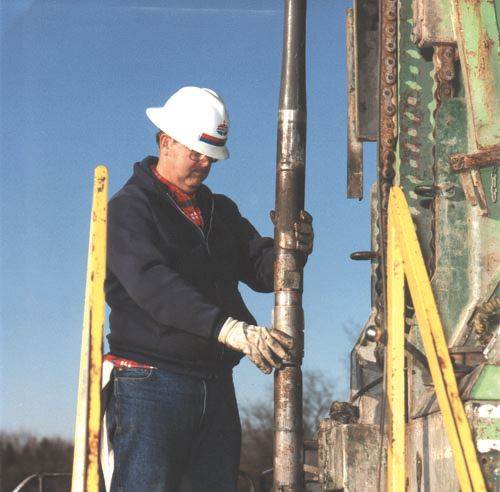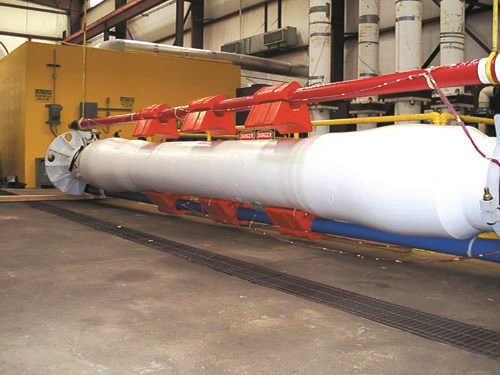Current Composite Drilling Riser Projects
.
ABB Vetco Gray has developed a unique approach to the MCI joining issue for its composite drilling riser design. Originally developed for the aerospace industry by Northrop Grumman and licensed to ABB Vetco Gray, the joint involves filament winding composite material over a tailpiece of steel to form the riser tube, using carbon fiber/epoxy prepreg material. Then the connection is prestressed and the gap created between the two materials is evacuated and filled with a noncompressible epoxy fluid that becomes solid over time. When the load is released, this prestressing maintains consistent operational loads. It also compensates for the difference in coefficients of thermal expansion (CTE) between the carbon and the steel.
The ABB Vetco Gray composite tubulars also feature a thermoplastic inner liner and rubber-based outer shield. The liner is installed after the body tube is manufactured. The company has developed a proprietary method for attaching the liner to the metallic end fitting to make the seal. ABB reports that the liner can be replaced in the field, as it wears.
In preparation for a field test, the ABB Vetco Gray riser joint has undergone extensive testing that included 750,000 fatigue cycles. The company has also developed a database that includes more than 150 samples of composite laminates that have undergone testing to identify their material properties and allowables.
Working with Brazil’s government owned oil company, Petrobras, ABB Vetco Gray plans to test the joint on a drilling riser string offshore Brazil. The composite joint will be moved to three different vertical locations on the riser string during the field test. Gauges similar to those used on steel risers will be installed on the composite riser and will offer real-time acoustic and strain-gauge measurement data on its performance.
Kværner and Conoco are carrying on a separate composite drilling riser program, the CompRiser project, which grew out of an earlier alliance between Conoco, Kværner and DuPont. The goal of this effort was to develop and field test a highpressure drilling riser joint that would satisfy all functional requirements, including operational loads, chemical resistance, and geometrical and operational requirements.
While Lincoln Composites was involved in initial development, Spencer Composites Corp. (Sacramento, Calif., U.S.A.) produced the latest full-sized version of the joint to undergo field testing. The company’s CompRiser system is made with Grafil Inc.’s (Irvine, Calif.) 12K carbon fiber and standard epoxy materials, in what company president Brian Spencer describes as an “unusual” proprietary filament winding process. For its inner seal, the riser uses a titanium liner rather than one made of thermoplastic. The CompRiser joint has titanium flanges, making it interchangeable with the standard titanium drilling riser currently used on Heidrun TLP in Norway, where a field test is currently underway.
Several prototypes were successfully tested to 15,859 psi/1,100 bar burst pressure and subjected to impact and bending fatigue loads that simulated a 150- year loading spectrum. Spencer says the prototype was subjected to factory acceptance tests and proof tests of 6,200 psi/440 bar. Once the joint arrived in Norway, a field pressure test was performed to 4,500 psi/310 bar before the riser went offshore. Tests showed that the CompRiser joint could withstand an impact from a steel casing joint falling off the platform and then still perform. Spencer notes that, due to lingering concern about potential damage from such an impact, the test riser was not installed closer to the water surface than 165 ft/50m during the test period.
Testing of the fullscale field joint commenced on July 21, 2001. The 50 ft/15m long, 22 inch/55 cm ID joint was incorporated into the riser string while drilling three Heidrun live wells, at three different locations in the riser string — just above the stress joint (at the wellhead), at mid-string, and just below the splash zone — for 45 days in each location. The composite joint was successfully used in drilling the three wells and has now been transferred to the Heidrun operator who has used the joint to drill a fourth well.
As a followup to the successful Heidrun field demonstration, Conoco and KOP, together with Petrobras, are building a composite riser joint with steel liner and steel connectors for installation on a drilling riser string offshore Brazil.
Related Content
Optimizing AFP for complex-cored CFRP fuselage
Automated process cuts emissions, waste and cost for lightweight RACER helicopter side shells.
Read MorePlant tour: National Institute for Aviation Research, Wichita, Kan., U.S.
NIAR, located at Wichita State University in the heart of the American aerospace manufacturing industry, has evolved to become a premier hub of teaching, R&D, creativity and innovation.
Read MoreThe next evolution in AFP
Automated fiber placement develops into more compact, flexible, modular and digitized systems with multi-material and process capabilities.
Read MoreMaterials & Processes: Fabrication methods
There are numerous methods for fabricating composite components. Selection of a method for a particular part, therefore, will depend on the materials, the part design and end-use or application. Here's a guide to selection.
Read MoreRead Next
Design Issues With Risers And Drill Pipe
The design characteristics of composites make them good material candidates for both risers and drill pipe. The high strength-to-weight ratio of composites means that they can be fabricated to withstand the same hydrostatic collapse pressures as steel, at a much lower weight — as much as 65 percent less on a p
Read MoreComposite Drill Pipe An Available Option
Lincoln has been producing flexible composite drill pipe for short-radius, horizontal drilling since 1991. Its nominal 2.375 inch /60.3 mm (OD), 30 ft/9m long pipe shaft is filament wound with 12K carbon fiber combined with glass fibers in epoxy resin over an elastomeric liner. Standard API rotary shoulder too
Read More

























